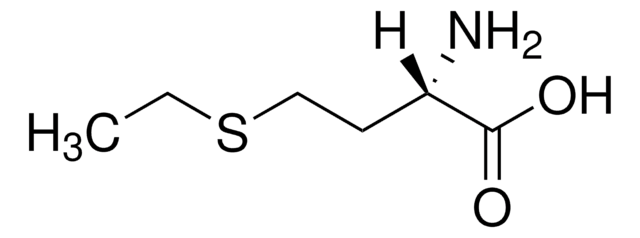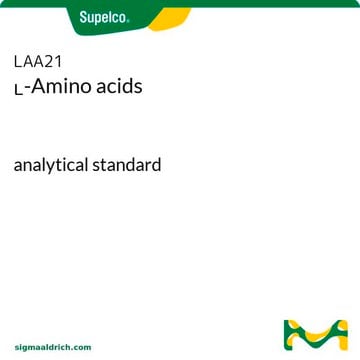E5139
DL-Ethionine
≥95% (TLC)
Synonyme(s) :
DL-2-Amino-4-(ethylthio)butyric acid
About This Item
Produits recommandés
product name
DL-Ethionine, ≥95% (TLC)
Pureté
≥95% (TLC)
Forme
powder
Couleur
white to off-white
Pf
269 °C
Application(s)
cell analysis
Température de stockage
−20°C
Chaîne SMILES
CCSCCC(N)C(O)=O
InChI
1S/C6H13NO2S/c1-2-10-4-3-5(7)6(8)9/h5H,2-4,7H2,1H3,(H,8,9)
Clé InChI
GGLZPLKKBSSKCX-UHFFFAOYSA-N
Vous recherchez des produits similaires ? Visite Guide de comparaison des produits
Application
- Superoxide dismutase activity as a measure of hepatic oxidative stress in cattle following ethionine administration.: This study evaluates the hepatic oxidative stress in cattle induced by ethionine administration by measuring superoxide dismutase activity. The findings suggest a significant oxidative response, highlighting the role of DL-Ethionine in studying liver oxidative mechanisms (Abd Ellah et al., 2009).
Actions biochimiques/physiologiques
Mention d'avertissement
Warning
Mentions de danger
Conseils de prudence
Classification des risques
Eye Irrit. 2 - Skin Irrit. 2 - STOT SE 3
Organes cibles
Respiratory system
Code de la classe de stockage
11 - Combustible Solids
Classe de danger pour l'eau (WGK)
WGK 3
Équipement de protection individuelle
dust mask type N95 (US), Eyeshields, Gloves
Certificats d'analyse (COA)
Recherchez un Certificats d'analyse (COA) en saisissant le numéro de lot du produit. Les numéros de lot figurent sur l'étiquette du produit après les mots "Lot" ou "Batch".
Déjà en possession de ce produit ?
Retrouvez la documentation relative aux produits que vous avez récemment achetés dans la Bibliothèque de documents.
Notre équipe de scientifiques dispose d'une expérience dans tous les secteurs de la recherche, notamment en sciences de la vie, science des matériaux, synthèse chimique, chromatographie, analyse et dans de nombreux autres domaines..
Contacter notre Service technique








